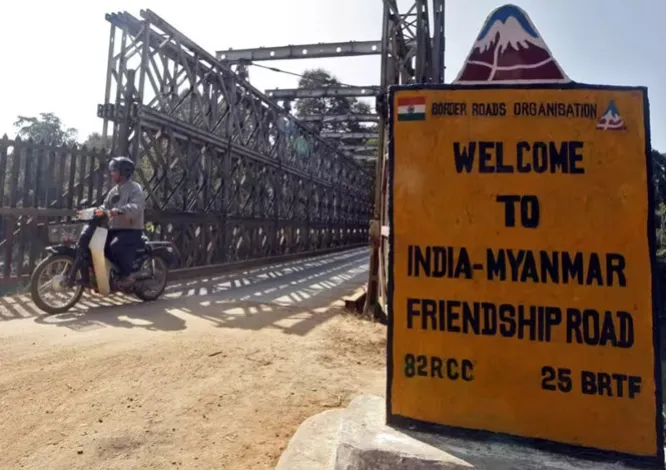The Free Movement Regime (FMR) along the India-Myanmar border has been a key aspect of the broader relationship between the two neighbours. Initiated in 1970, the FMR experienced a resurgence in 2016, finding a place within the broader Act East Policy of New Delhi. This regime permits individuals residing within a 16 km radius of the border to traverse freely, unfettered by the usual requirements of a visa or other documentation.
However, recent developments have cast a pall over this once-celebrated arrangement, compelling the Indian government to initiate a dialogue with Myanmar authorities to consider the termination of this unrestricted border movement and contemplate fortifying it with fencing.
The Free Movement Regime (FMR) along the India-Myanmar border was shaped by the deep ethnic and familial connections between residents of India and Myanmar’s Chin state. The Mizo, Kuki, and Chins, collectively known as Zo people, share a common ancestry and robust ethnic ties. Historical border delineations influenced more by political considerations than ethnic affinities during the British colonial era resulted in the dispersion of Zo people across international boundaries.
Acknowledging these historical ties, the border with Myanmar has been predominantly unfenced, except for a small section in Manipur covering approximately 10 km. The border, cutting through dense forests, poses challenges for effective monitoring and control. Mizoram shares a porous 510-km-long border with Myanmar, while Nagaland and Arunachal Pradesh have boundaries of 215 km and 520 km, respectively, fostering cultural linkages between tribes .
The reconsideration of the FMR is grounded in the unsettling realities of insurgencies, smuggling, the drug trade, and the increased influx of Myanmar nationals following the 2021 coup. This became particularly prominent last year in the context of the ethnic conflict in Manipur, where the Meitei community attributes the tensions to the perceived illegal migration of tribal Kuki-Chin communities from Myanmar. The Kukis in Manipur accuse them of exploiting this situation for their benefit. The FMR now faces scrutiny amid the intricate interplay of historical ties and present challenges.
The reconsideration of the FMR is grounded in the unsettling realities of insurgencies, smuggling, the drug trade, and the increased influx of Myanmar nationals following the 2021 coup.
The heightened scrutiny of the FMR can be attributed to various factors, with one significant concern arising from the surge in drug production in Myanmar. A report from the United Nations Office on Drugs and Crime (UNODC) underscores the security implications for the region as the consistent flow of narcotics from Myanmar’s clandestine labs persists. While the direct link to Myanmar’s political turmoil remains speculative, the involvement of various stakeholders, including elements within the military regime, adds complexity to the situation.
In Manipur, the aftermath of the military junta’s resurgence in Myanmar in 2021 has seen a notable increase in drug seizures, soaring from nearly 3 tonnes in 2021 to over 10 tonnes within a year. The Assam Rifles, from January to October 2023, recovered 18 weapons, contraband items worth $889,000, and drugs worth $10.96 million. The vulnerable regions identified for smuggling and infiltration, spanning 500 km primarily in Arunachal Pradesh, Manipur, and Mizoram, amplify these concerns.
The border narrative becomes more intricate with an influx of over 44,000 displaced individuals into Mizoram, Manipur, Nagaland, and Arunachal Pradesh. Directives to gather biometric information from refugees and infiltrators aim to create a list, restricting access to documents like Aadhaar and voting cards meant for citizens. While Manipur is moving ahead with this, the Mizoram government is not on board as they emphasise familial and ethnic links with Myanmar. Mizoram CM Lalduhoma has already conveyed his reservations about proceeding with border fencing.
Operation 1027, orchestrated by the Brotherhood Alliance, has further escalated the situation. The exodus of a few hundred junta soldiers seeking sanctuary in Mizoram as their official posts are destroyed and taken over by the Myanmar resistance groups creates a vivid backdrop against which India must reassess its course of action. The current state of affairs challenges the junta’s authority and places India in a complex situation with historical entanglements and evolving conflict dynamics.
The border narrative becomes more intricate with an influx of over 44,000 displaced individuals into Mizoram, Manipur, Nagaland, and Arunachal Pradesh.
Against this backdrop, it is perhaps imperative for New Delhi today to introduce more explicit provisions for better regulation of movement along the border, allowing for a more nuanced adjustment to address concerns associated with the FMR. As the military junta loses control over the border areas, challenges are mounting even as economic ramifications are becoming apparent. Disruptions to ambitious projects like the Kaladan Multi-Modal Transit Transport Project reflect a hiatus in progress, emphasising the vulnerability of economic initiatives amid conflict. The revival of the economic agenda hinges on a return to stability, symbolised by the elusive prospect of a federal democracy in Myanmar.
While the Indian government has communicated this imperative to its Myanmar counterparts, its realisation demands significant changes within the decision-making structures of the State Administration Council (SAC). These changes should align with the sentiments of the people and ethnic groups, which remain a distant aspiration.
A rethink on FMR is part of a broader strategic recalibration as New Delhi navigates the complexities of the Indo-Myanmar border situation. The road ahead requires diplomatic finesse, adaptability, and collaborative efforts to ensure lasting stability and prosperity in the region.
This commentary originally appeared in Financial Express.
The views expressed above belong to the author(s). ORF research and analyses now available on Telegram! Click here to access our curated content — blogs, longforms and interviews.




 PREV
PREV



